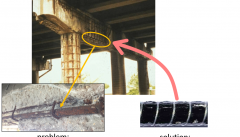
Laboratoire
Soutenance de Thèse de ASTERIOS VALOGIANNIS intitulée " Contribution to the study of the behavior of concrete structures reinforced with carbon FRP bars’’ le 19 novembre 2024 à 14h à la salle IOA 1er étage du bâtiment FREYSSINET.
Steel corrosion is one of the main causes of mechanical deterioration of reinforced concrete structures during their lifetime. A promising alternative for the reinforcement is the Fiber Reinforced Polymer (FRP) bars. These bars are also being studied in the context of reinforcing the underground structures that will host the radioactive waste produced in France, through related research projects carried out by the French National Agency for Radioactive Waste Management (ANDRA).The research conducted through this PhD thesis contributes to gaining more knowledge about the behavior of these bars by focusing on their interaction with concrete. This study will contribute to the design of concrete structures reinforced with these materials. Four types of carbon FRP (CFRP) bars were selected for this study, which differ, among others, in their surface treatment as follows: ribbed, sand-coated, smooth and twisted bars. Conventional steel bar is also used for comparison purposes.Steel-reinforced and CFRP-reinforced cubic concrete samples with 20 cm on each side are tested in pull-out loading to evaluate and quantify the concrete/bar bond behavior. Each CFRP bar exhibits a different bond performance attributed mainly to the composition and geometry of their outer surface, with ribbed bar presenting the highest bond strength among CFRP bars. Some of the CFRP-reinforced samples are also subjected to partial pull-out loading, while others remain unloaded.Cylindrical samples of 0.6-2.5 cm thickness and 4.2 cm in diameter obtained by core drilling from the CFRP-reinforced samples are studied using Scanning Electron Microscopy/Energy Dispersive Spectroscopy, indentation and push-out tests. The objective is to understand the interface behavior and its failure mechanisms by also conducting a chemical qualitative analysis. One of the notable results is the poor concrete-carbon fibers bond and the good concrete-polymer bond.Bond strength values obtained from the pull-out tests with CFRP bars are converted to anchorage length in beams. This additionally requires the determination of parameters resulting from the beam design. A steel-reinforced concrete beam is also studied for comparison purposes.

